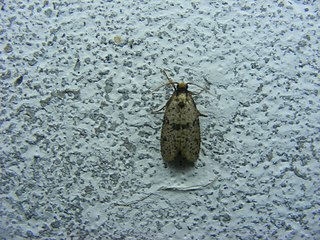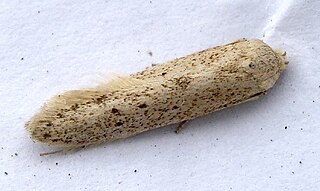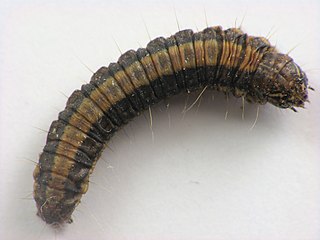
Eriocottidae or Old World spiny-winged moths is a family of insects in the order Lepidoptera whose position relative to other members of the superfamily Tineoidea is currently unknown. There are two subfamilies, Compsocteninae and Eriocottinae.

The Blastobasidae are a family of moths in the superfamily Gelechioidea. Its species can be found almost anywhere in the world, though in some places they are not native but introduced by humans. In some arrangements, these moths are included in the case-bearer family (Coleophoridae) as subfamily Blastobasinae. The Symmocidae are sometimes included in the Blastobasidae as subfamily or tribe.

Anacampsis is a worldwide genus of moth with most found in the nearctic and neotropical regions. It is in the family Gelechiidae. The larvae feed on a range of deciduous trees and shrubs in a rolled or folded leaf, or spun shoot.

Anarsia is a genus of moths in the family Gelechiidae.
Compsolechia is a genus of moths in the family Gelechiidae.

Dichomeris is a genus of moths in the family Gelechiidae erected by Jacob Hübner in 1818.
Auximobasis is a genus of the gelechioid moth family Blastobasidae. It is sometimes included in Blastobasis.

Blastobasis is the type genus of the gelechioid moth family Blastobasidae; in some arrangements these are placed in the case-bearer family (Coleophoridae) as a subfamily. Within the Blastobasidae, the subfamily Blastobasinae has been established to distinguish the Blastobasis lineage from the group around Holcocera, but the delimitation is not yet well-resolved.

Scoparia is a grass moth genus of subfamily Scopariinae. Some authors have assigned the synonymous taxon Sineudonia to the snout moth family (Pyralidae), where all grass moths were once also included, but this seems to be in error.

Lecithocera is a genus of moths in the lecithocerid subfamily Lecithocerinae. The genus was erected by Gottlieb August Wilhelm Herrich-Schäffer in 1853.

Labdia is a genus of moths in the family Cosmopterigidae.

The Epipaschiinae are a subfamily of snout moths. More than 720 species are known today, which are found mainly in the tropics and subtropics. Some occur in temperate regions, but the subfamily is apparently completely absent from Europe, at least as native species. A few Epipaschiinae are crop pests that may occasionally become economically significant.

Autosticha is a genus of gelechioid moths. It belongs to the subfamily Autostichinae, which is either placed in the concealer moth family (Oecophoridae), or in an expanded Autostichidae. It is the type genus of its subfamily. Originally, this genus was named Automola, but this name properly refers to a fly genus in family Richardiidae.
Auximobasis agrestis is a moth in the family Blastobasidae. It was described by Edward Meyrick in 1922. It is found in Pará, Brazil.
Auximobasis angusta is a moth in the family Blastobasidae. It was described by Edward Meyrick in 1922. It is found in Colombia and Ecuador.
Auximobasis flavida is a moth in the family Blastobasidae. It was described by Edward Meyrick in 1922. It is found in Peru and Pará, Brazil.
Auximobasis prolixa is a moth in the family Blastobasidae. It was described by Edward Meyrick in 1922. It is found in Peru.
Auximobasis incretata is a moth in the family Blastobasidae. It was described by Edward Meyrick in 1931. It is found in Peru.
Auximobasis invigorata is a moth in the family Blastobasidae. It was described by Edward Meyrick in 1932. It is found on the Virgin Islands.
Auximobasis obstricta is a moth in the family Blastobasidae. It was described by Edward Meyrick in 1918. It is found in Guyana.










